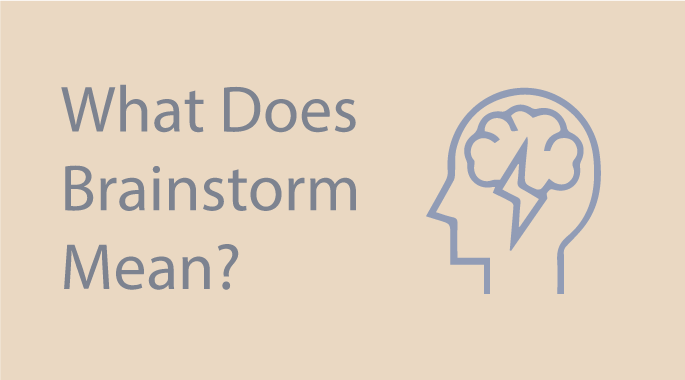Brainstorming is a critical component of idea generation and creative problem-solving. In this comprehensive article, we will delve into what brainstorm means and its significance, exploring the intricacies of this invaluable process.
Brainstorming is a creative process that encourages individuals or groups to come together and generate a plethora of ideas related to a specific topic or problem. In essence, when we ask, “What does brainstorm mean?” Brainstorm means engaging in an open, non-judgmental discussion to explore various possibilities. Whether you’re brainstorming for business solutions, creative endeavors, or tackling challenges, the key is to generate a wide range of ideas without criticism, and that’s precisely what brainstorming means.

Table of Contents
Introduction
Brainstorm means ‘a thinking process which is dynamic’. It plays a pivotal role in generating innovative ideas and solutions to various challenges. It’s a term you’ll frequently encounter in business meetings, educational settings, and creative endeavors. But what does it truly mean, and why is it so vital? Let’s embark on a journey to uncover the depths of brainstorm meanings.
What Does Brainstorm Mean?
At its essence, brainstorm meaning is a structured approach to idea generation. It encourages individuals or teams to think creatively and share their thoughts without fear of criticism or judgment. This open and non-evaluative environment allows the free flow of ideas, often leading to unconventional and ingenious solutions. Brainstorming’s primary objective is to amass a large number of ideas for subsequent evaluation and implementation.
The Brainstorming Process
The process of brainstorming follows a specific sequence:
1. Define the Problem: Brainstorming sessions kick off by defining the problem or topic under consideration. This initial step provides clarity and ensures everyone is on the same page.
2. Generate Ideas: Participants are then encouraged to generate as many ideas as possible, emphasizing quantity over quality. This phase involves open discussions, free thinking, and a “no idea is a bad idea” mentality.
3. Evaluate Ideas: After the idea generation phase, it’s time to evaluate the ideas. Participants sift through the pool of ideas, selecting the most promising ones for further development.
4. Refine and Develop: The selected ideas undergo refinement and development. This stage might include merging ideas, enhancing their feasibility, or expanding upon their core concepts.
5. Implement Solutions: The final step involves putting the chosen ideas into action. Brainstorming is not merely an exercise in idea generation; it’s a catalyst for tangible results.
The Benefits of Brainstorming
Brainstorming is a versatile technique that offers a multitude of benefits:
- Fosters Creativity: It sparks creativity by allowing individuals to think outside the box and explore unconventional solutions.
- Enhances Collaboration: Brainstorming encourages collaboration among team members, fostering an atmosphere of teamwork and mutual support.
- Expands the Idea Pool: The technique promotes diverse thinking, leading to a wider range of ideas and solutions.
- Improves Problem-Solving: Brainstorming enhances problem-solving skills by cultivating a culture of innovation.
- Facilitates Effective Communication: Effective brainstorming sessions improve communication, ensuring everyone’s voices are heard.
Techniques for Effective Brainstorming
Effective brainstorming relies on the use of various techniques:
1. Mind Mapping: Mind mapping involves creating visual diagrams that represent ideas and their interconnections, helping participants visualize their thoughts.
2. Brainwriting: In this technique, participants silently generate ideas in writing, promoting focused idea generation.
3. SWOT Analysis: Utilizing SWOT analysis, participants assess strengths, weaknesses, opportunities, and threats, enabling a comprehensive understanding of the problem.
4. Rolestorming: Rolestorming encourages participants to take on different personas, offering fresh perspectives and unique insights.
5. Reverse Brainstorming: In this approach, participants identify problems or obstacles, which can lead to the discovery of innovative solutions.
Conclusion
In conclusion, brainstorming is a powerful and versatile tool that has applications in various aspects of life. Whether you’re seeking innovative solutions in business, creative inspiration in the arts, or simply looking to enhance your problem-solving skills, brainstorming is a valuable process at your disposal. It encourages free thinking, fosters collaboration, and paves the way for creative and innovative ideas.
FAQs
Q1: How do I start a successful brainstorming session?
A1: Begin by defining the problem or topic clearly, and ensure a diverse group of participants. Encourage open and non-judgmental discussions.
Q2: Can individuals benefit from brainstorming, or is it more effective in groups?
A2: Brainstorming can be valuable for both individuals and groups. Solo brainstorming allows for personal idea generation, while group brainstorming encourages collaboration.
Q3: What are some famous examples of successful brainstorming?
A3: Examples include the innovative ideas generated during the development of Google’s search algorithms and the creative brainstorming sessions at Pixar, which led to iconic animated films.
Q4: Are there any online tools or software for virtual brainstorming?
A4: Yes, there are various online platforms and tools designed for virtual brainstorming, such as Miro, Stormboard, and Trello.
Q5: What is the role of a facilitator in a brainstorming session?
A5: A facilitator helps guide the brainstorming process, ensuring that it remains on track, all participants have a chance to contribute, and the atmosphere is conducive to creativity.
Q6: How can I overcome common challenges in brainstorming, such as groupthink?
A6: To address challenges like groupthink, it’s important to encourage open-mindedness, diversity of thought, and the consideration of a wide range of ideas.
Q7: What are the other synonyms of brainstorming?
A7: There are many synonyms for ‘brainstorming’ which you can find in this post.